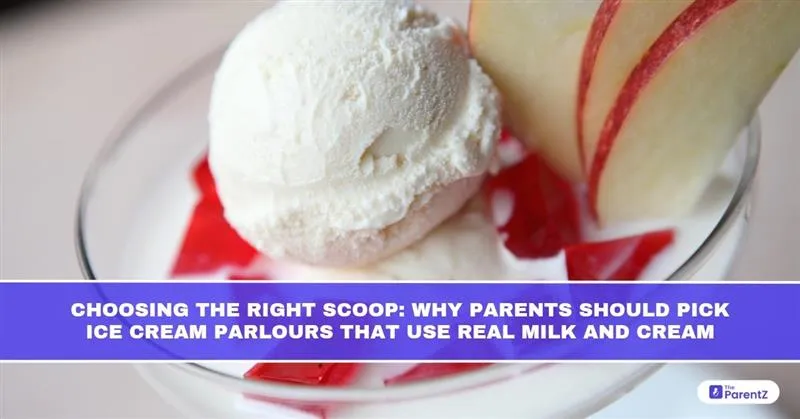A Simple Scoop, A Serious Choice
It seems like a harmless outing, your child pulls you by the hand toward their favourite ice cream parlour. Rows of colourful tubs, cheerful names, and that unmistakable sweetness in the air. But behind the counter lies a decision many parents don’t realise they’re making:
Is this real ice cream, or just a processed imitation?
Most parlours won’t say it out loud, but the truth is clear in the ingredients; many no longer serve milk-based ice cream. What’s in the cone could be a frozen dessert made from vegetable oils, artificial stabilisers, and added flavours designed to mimic real cream but lacking its natural benefits.
For growing children, that difference isn’t cosmetic. It’s biological.
The Dairy Difference: Why Real Milk and Cream Matter
Real ice cream, at its core, contains:
- Milk fat (from cow or buffalo milk)
- Milk solids
- Natural sugars like lactose
This combination offers more than taste; it supports calcium absorption, gut comfort, and dental resilience.
On the other hand, frozen desserts (often sold in parlours under vague brand labels) swap milk with:
- Palm kernel oil
- Hydrogenated vegetable fat
- Corn syrup solids
They may look and taste similar, but the body processes them very differently.
What Happens Inside a Child’s Body?
Here’s what real milk-based ice cream provides:
- Bioavailable calcium for bones and teeth
- Phosphorus and Vitamin A that support enamel and immunity
- Natural fat that’s easy to digest in small quantities
Now contrast that with frozen dessert alternatives:
- Non-dairy fat that slows digestion and may cause bloating
- No significant calcium unless added synthetically
- Trans fats and emulsifiers that have no nutritional benefit for children
From a dentist’s view, children who frequently consume low-quality frozen desserts often present with:
- Sticky plaque that resists brushing
- Early enamel erosion
- Occasional lip or tongue irritation from artificial flavors
Why Parlours Matter More Than Supermarkets
In supermarkets, you can flip the packet. At parlours, you rely on transparency and sadly, it’s often missing.
Large parlour chains or franchises frequently:
- Use bulk tubs from industrial manufacturers that supply “frozen dessert” instead of milk-based ice cream
- Label flavors attractively without disclosing ingredients
- Add stabilizers to maintain texture across storage temperatures
Even artisanal parlours may cut corners, claiming natural status but using pre-made bases or powders mixed with oil and sugar syrup.
So, what can you do as a parent?
Five Simple Questions to Ask Before Buying
When in doubt, ask. A good parlour that uses real ingredients will answer confidently.
- Is this made from real milk and cream or vegetable fat?
- Do you prepare your base in-house or use a premix?
- Is the product labelled “ice cream” or “frozen dessert”?
- Can I see the ingredients used in a single flavor?
- Do you avoid artificial colours and synthetic stabilisers?
If the staff hesitates or seems unsure, it’s a red flag.
How to Spot a Quality Scoop (Even Without the Label)
Even if you don’t get a clear answer, your senses can help:
- Texture: Real dairy ice cream melts slowly and evenly; oil-based versions feel greasy or coat the mouth unnaturally.
- Taste: True creaminess is subtle and rich not cloyingly sweet or artificial.
- After-feel: Quality ice cream leaves your mouth feeling clean, not sticky or dry.
Children may not always notice the difference, but their bodies do.
Building Healthy Habits Without Saying No
Ice cream isn’t the enemy. Overexposure to low-grade frozen desserts is.
Here’s how to balance:
- Choose parlours that display sourcing and process clearly
- Opt for fruit or nut-based flavors they usually contain less artificial content
- Visit parlours that make small batches or offer tastings they’re often more transparent
- Turn parlour visits into occasional celebrations, not weekly rituals
If your child loves ice cream, encourage curiosity. Let them ask how it’s made, or even better, make a simple version at home together. Teaching them about quality now builds lasting habits.
From a Dentist’s Chair: What I Want Every Parent to Know
“I see cavities that don’t come from sweets, but from sweet habits. Children who grow up on real food, even real desserts, often have fewer dental issues than those constantly exposed to ultra-processed frozen desserts.”
— A Dentist Who Works With Children Daily
Milk-based treats, when enjoyed occasionally, offer flavour with a touch of nutrition. But oil-based frozen desserts provide only sugar, fat, and long-term consequences.
Final Thoughts: The Real Scoop Isn’t on the Menu
When it comes to frozen treats, don’t let branding fool you. A fancy scoop doesn’t always mean a healthy one.
Pick parlours that value ingredients. Choose ice creams made with milk and cream, not marketing and oil. Because what your child eats today, especially when it’s sweet, shapes their health, taste, and smile for years to come.








Be the first one to comment on this story.